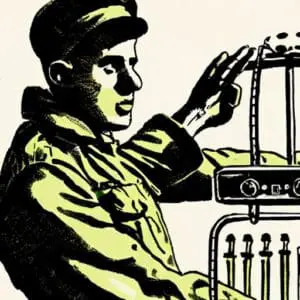The phonetic alphabet, also known as the NATO phonetic alphabet or international radiotelephony spelling alphabet, is a special alphabet used by the US Army, British Forces, and other military branches worldwide. This system was originally developed to provide a clearer way of spelling out words, letters of the English alphabet, or numbers over radio or other communication devices. The phonetic alphabet is crucial for ensuring accurate communication, particularly in noisy or challenging environments where misunderstandings could have serious consequences.
Each letter in the phonetic alphabet is represented by a word beginning with that letter. For example, to spell “DOG” using the NATO phonetic alphabet, you would say: “Delta Oscar Golf.” The first letter of each word corresponds to the letters in “DOG” (D, O, G). This system is widely used across various fields, including military, aviation, and telecommunications.
The phonetic alphabet was standardized by organizations such as the International Civil Aviation Organization (ICAO) and the International Telecommunication Union (ITU), ensuring consistent usage across different countries and industries. The alphabet includes 26 letters and their corresponding 26 code words, such as “Alpha Bravo Charlie Delta.”
Each letter in the phonetic alphabet is actually a word beginning with that letter.
For example, in order to spell “DOG” using the phonetic alphabet, using the alphabet chart below, you would say: “Delta Oscar Golf.”
Did you notice the first letter of each word used? “D.O.G.”.
The phonetic alphabet is just that easy! Use the alphabet chart below to see what each letter and number is in the phonetic alphabet:
Phonetic Alphabet Letter Chart
| Letter | Phonetic Word | Pronunciation |
|---|---|---|
| A | Alpha | al-fuh |
| B | Bravo | brah-voh |
| C | Charlie | char-lee |
| D | Delta | dell-tuh |
| E | Echo | eck-oh |
| F | Foxtrot | foks-trot |
| G | Golf | golf |
| H | Hotel | ho-tell |
| I | India | in-dee-uh |
| J | Juliet | joo-lee-et |
| K | Kilo | kee-loh |
| L | Lima | lee-muh |
| M | Mike | myk |
| N | November | noh-vim-ber |
| O | Oscar | os-ker |
| P | Papa | pah-Pah |
| Q | Quebec | kee-bek |
| R | Romeo | roh-mee-oh |
| S | Sierra | see-air-uh |
| T | Tango | tang-oh |
| U | Uniform | yoo-nee-form |
| V | Victor | vik-ter |
| W | Whiskey | wiss-kee |
| X | X-Ray | ecks-ray |
| Y | Yankee | yayn-kee |
| Z | Zulu | zoo-loo |
Phonetic Alphabet Numbers
In addition to the letters, the phonetic alphabet also includes numbers, each with its own pronunciation to provide clarity. While most numbers are pronounced as you would normally say them, some are slightly modified to ensure they are easily understood in all conditions. This adaptation is especially important in international communication, where accents and language differences might otherwise cause confusion.
The phonetic alphabet is closely related to the International Phonetic Alphabet (IPA), which uses IPA symbols and the IPA chart to represent sounds in all spoken languages. While the IPA focuses on the pronunciation of words in different languages, the phonetic alphabet is specifically designed for spelling out words and numbers clearly in a standardized way.
Originally known as the Joint Army Navy Phonetic Alphabet or Army Navy Phonetic Alphabet, this system has evolved over time and is now widely accepted and used in international contexts. The International Phonetic Alphabet (IPA) also plays a role in understanding the pronunciation of words across different languages, making it a valuable tool in linguistics and communication.
Understanding and using the phonetic alphabet is essential for anyone involved in military, aviation, or international communication. It’s a simple yet powerful tool that ensures your message is heard loud and clear, no matter where you are.
| Number | Phonetic Word | Pronunciation |
|---|---|---|
| 0 | Zero | zee-roh |
| 1 | One | wun |
| 2 | Two | too |
| 3 | Tree | tree |
| 4 | Fower | fa-wer |
| 5 | Fife | fife |
| 6 | Six | siks |
| 7 | Seven | seh-vin |
| 8 | Eight | ate |
| 9 | Niner | ny-ner |
